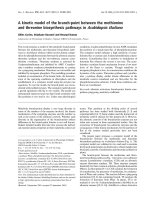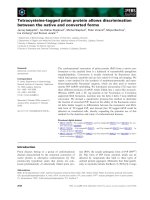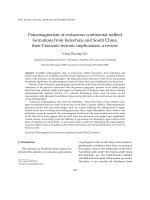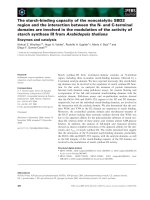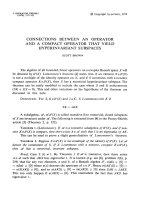1996a fish suggests continental connections between the indochina and south china
Bạn đang xem bản rút gọn của tài liệu. Xem và tải ngay bản đầy đủ của tài liệu tại đây (719.78 KB, 4 trang )
Fish suggests continental connections between the Indochina
and South China blocks in Middle Devonian time
Tong-Dzuy Thanh D e p a rtm e n t o f G eology, Vietnam National U niversity, 90, Nguyen
Philippe Janvier URA 12 du CNRS, L a bo ratoire de P aléontologie, M useum National
Trai, Dong Da, Hanoi, Vietnam
d ’H istoire N aturelle, 8, rue B u ffon ,7 50 05
Paris, France
Ta Hoa Phuong
D e p a rtm e n t o f G eology, V ietnam National University, 90, Nguyen Trai, Dong Da, Hanoi, Vietnam
ABSTRACT
A yunnanolepiform antiarch (placoderm fish) is recorded from the Givetian Dong
Tho Formation of Quang Binh Province, central Vietnam. This and other fishes from the
same locality occur in marginal marine, detrital facies, with plant remains and lingulid
bra-chiopods that indicate a nearshore to deltaic environment. Yunnanolepiform antiarchs were
hitherto known exclusively from the Lower Devonian of the South China block. The new
occurrence of this group well south of the Song Ma suture suggests close links between the
Indochina and South China blocks in Middle Devonian time. The massive sandstone ex
posures of the Dong Tho Formation may be a southern extension of the Do Son Sandstone
Formation of the Hai Phong area, which is located on the South China block.
INTRODUCTION
The marine Devonian faunal assemblages
from shallow-water and marginal platform
facies of the South China block have long been
known to be largely endemic. This en-demism
is particularly well marked in the Silurian and
Early Devonian; some taxa survived until the
L ate Devonian. Fishes, in particular, are
rep rese n ted by several higher taxa
(yunnanolepiform and procondylolepi-form
antiarchs
am ong
placoderm s,
and
youngolepiforms among sarcopterygians) that
w ere regarded as unique to the Silurian and
Devonian of the South China block. A group
of jawless fishes, the galeaspids, is especially
abundant and diversified in the Si-lurian and
Early Devonian of South China, but is now
known to occur in the North China block and
in northern Tarim (Liu, 1995). These major
fish taxa w ere not previously known to occur
outside these two blocks, despite an exten
sive Devonian vertebrate record from A us
tralia, N orth Amer-ica, Europe, and Siberia.
Y oung (1981, 1990, 1993) therefore coined
the name “galeaspid-yunnanolepid province”
for this faunal province of A sia in SilurianDevo-nian time. The invertebrate faunas, in
particular brachiopods, display much the
same endemism, for example, the Pragian
Eu-ryspirifer tonkinensis and the Howittia
wangi faunal assemblages. These character
istic faunas are easily traced into Vietnam,
as far to the south as the Bac Thai and even
the Song D a (Black River) areas. The Low
er Devonian sequence in southern Yunnan,
Guangxi, and Bac Bo (northern Vietnam)
generally consists o f L ochkovian te rrig
enous sediments of Old R ed Sandstone fa
cies (the Lianhuashan Form ation in China
and the Si Ka Form ation in the Bac Bo),
Geology; June 1996; v. 24; no. 6; p. 571-574; 2 figures.
overlain by m ore marine and pelagic facies
throughout the Devonian, with a short detrital (possibly nonm arine) episode in the
Givetian or early Frasnian in the east (east
ern Bac Bo).
In the Song D a area of Vietnam, the fa
cies of the Devonian are somewhat differ
ent, having deeper facies, and farther south,
in central V ietnam (Trung Bo), the classical
Devonian lithological sequence of the north
reappears with much the same divisions
(terrigenous at the base and progressively
m ore marine and pelagic toward the top,
and a Givetian-early Frasnian detritic episode
locally), but quite different invertebrate fau
nas. The typical Euryspirifer tonkinensis and
Howittia wangi faunal assemblages of the
north, for example, have never been found
in central Vietnam. However, some wide
spread taxa, in particular among tabulates
and corals, have been recorded in both areas
(Tong-Dzuy, 1993).
Southeast Asia is considered to have
form ed by accretion of several terranes,
some originating from Gondwana in the
early Paleozoic. W ithin V ietnam the Song
M a suture forms the boundary between the
South China block in the north and the In
dochina terrace in central and southern
V ietnam (Fig. 1A). Consistent with this is
the marked difference in the Devonian in
vertebrate faunas of northern and central
V ietnam, which has been interpreted to in-
- I _________ I_________ I_________ L .
A,
C H INA
'o.
;
Dai Giang Formation
(Upper Silurian - Lower Devonian)
II I II Rao Chan Formation
(Lower Devonian)
Ban Giang Formation
(Eifelian)
EZ3 Dong Tho Formation
Pre - Lower
Carboniferous granite
(Givetian - ?Lower Frasnian)
Carboniferous
□
Quaternary
Figure 1. A: General map of Vietnam showing position of main sutures and location of two major
exposures of Middle Devonian sandstone discussed here, Do Son Sandstone Formation at Do
Son and Dong Tho Formation at Ly Hoa. B: Geologic map of Ly Hoa area (from Tong-Dzuy et
al., 1994a). Vertebrate localities: 1, outcrop situated near Da Nhay (Tong-Dzuy et al., 1994a); 2,
quarry along highway at Ly Hoa Pass.
571
dicate some kind of paleogeographical bar
rier (e.g., a wide ocean) between the South
China and Indochina blocks in Devonian
time. A fish fauna was recently discovered in
the Middle Devonian Dong Tho Formation
at Ly H oa, Q uang Binh Province, central
Vietnam, in association with lingulid brachiopods, bivalves, and terrestrial plant re
mains. It comprises at least one of the typical
South Chinese fish taxa, the yunnanolepiform antiarchs. This discovery strongly sug
gests close biogeographical relationships b e
tween the South China and Indochina
blocks in Devonian time.
DONG THO AND MUC BAI
FORMATIONS
Relatively large Devonian exposures are
present in the Q uang Binh Province of cen
tral V ietnam, east of Cape Ly H oa and
south of the G ianh River (Song Gianh)
(Fig. 1B), in the southern p art of the Truong
Son anticlinorium. Four Devonian form a
tions are recognized in this area: the Early
Devonian R ao Chan Form ation, the Eifelian Ban Giang Form ation, and the Givetian-?early Frasnian Muc Bai and Dong
Tho formations, which represent two differ
ent but probably synchronous facies (TongDzuy, 1993; Tong-Dzuy et al., 1994a). The
D ong Tho Form ation consists of massive
sandstones, with rare argillaceous lenses,
and the Muc Bai Form ation mainly com
prises terrigenous sediments in its lower
part, and marls, grayish limestones, and in
terbedded sandstones and shales in its upper
part. The Muc Bai Form ation yields a coral
and brachiopod fauna of Givetian to possi
bly early Frasnian age. The Muc Bai F or
mation is widespread to the west of this
area, whereas the D ong Tho Formation
crops out near the m outh of the Gianh River
and along the coast. The relationship be
tween the two formations is still unclear, but
it seems that the D ong Tho Form ation is
merely a more marginal to deltaic facies of
the Muc Bai Formation, as the latter be
comes more detrital eastward (Tong-Dzuy,
1993; Nguyen H uu et al., 1995). The Dong
Tho Form ation crops out at Cape Ly Hoa,
w here it forms a slightly hilly area traversed
by the H anoi-H o Chi Minh City highway
(Ly H oa Pass). H ere it is almost barren, and
only fish remains have been found in one
particular level, in association with lingulids
and bivalves. Some fine-grained sandstone
lenses also yield indeterm inate plant re
mains, mainly lycophyte leaves and stem
fragments. F arther to the west, west of Minh
Le, black marls interbedded in the Dong
Tho Form ation contain relatively large (up
to 4 cm in diam eter) stems of lycophytes (of
Protolepidodendron and Lepidodendropsis
572
type), as well as a rich spore assemblage that
suggests a Givetian age (Tong-Dzuy and
Cai, 1995). This spore assemblage is quite
similar to that of the Givetian H aikou F or
mation of Yunnan. The fishes found to date
in the Dong Tho Form ation clearly belong
to Devonian taxa but are somewhat anach
ronistic: they all belong to groups (e.g., yunnanolepiforms, phlyctaeniids, and youngolepiforms) that are either mainly or
exclusively known from the Early Devonian
on the South China block. This discrepancy
is provisionally attributed here to ende
mism, because there is no evidence that the
Dong Tho Form ation extends into the
Lower Devonian. M oreover, some large
plant remains, as yet indeterminable, found
in association with the fish remains rule out
an Early Devonian age because of their size.
The cross-bedding of the D ong Tho F or
mation is progressively more conspicuous to
the east, and this suggests an increasingly
deltaic environment. Considering the thick
ness of this formation, it seems probable
that it corresponds to the margin of an im
portant landmass that extended east of this
area in Middle Devonian time.
LY HOA FISH FAUNA
Fish remains have been found at two
places in the outcrop of the Dong Tho F or
mation at Cape Ly H oa, at the southern end
of Ly H oa beach. O ne is a small lens of bio
turbated clayey sandstone, opposite the D a
Nhay (“dancing rock”; 1, Fig. 1B), and the
other is a layer of clayey sandstone in a small
quarry on the side of the H anoi-H o Chi
Minh City highway, at the top of the Ly H oa
Pass (2, Fig. 1B). The two localities are only
1 km apart, and considering the similar lithology (clayey sandstone) and local struc
ture (a 40°SE dip), they probably corre
spond to the same level of the formation.
Fish remains were first discovered from
locality 1 (Tong-Dzuy et al., 1994a). They
included various poorly preserved placoderm remains and almost com plete thoracic
arm or of a phlyctaeniid arthrodire, Lyhoalepis duckhoai, which did not provide biogeographical information, because it is unique
in many respects, and does not clearly show
any particular affinities with other phlyctaeniid arthrodire genera from China or else
where. In 1994, the second locality yielded
more significant fish remains that could be
identified as belonging to antiarchs and sarcopterygians. A ntiarchs are a group of placoderms whose pectoral fins are modified
into jointed appendages, and which are gen
erally restricted to marginal, deltaic, and
possibly fresh-water facies. They usually
show a m arked endemism and are among
the biogeographically m ost significant De-
Figure 2. A: Anterior ventrolateral plate of tho
racic arm or of yunnanolepiform antiarch ,
Dong Tho Form ation, Ly Hoa, Quang Binh
Province, Vietnam (br. is brachial articulation).
B: Yunnanolepis parvus Zhang, Lower Devo
nian or Yunnan, China (after Zhang, 1982),
thoracic arm or in ventral view, showing ante
rior ventrolateral plate (stippled) and brachial
articulation area (br.). Scale bar: 5 mm.
vonian vertebrates. For example, 19 of the
40 antiarch genera are endemic to South
China. The antiarch m aterial from Ly H oa
includes derm al plates of a yunnanolepiform, one of the antiarch groups hitherto
known exclusively from the South China
block. The m ost characteristic of these
plates is a right anterior ventrolateral plate
of a small yunnanolepiform (Fig. 2A), orna
m ented with coarse, scattered tubercles.
The area for the articulation of the pectoral
fin is a small recess devoid of any articular
device or brachial process (br., Fig. 2A), and
there is no axillary foramen. It is thus similar
to that of the classical yunnanolepiforms,
such as Yunnanolepis from the Early Devo
nian of Y unnan and northern Vietnam (br.,
Fig. 2B). T he proportions of this plate,
which is remarkably short and broad, are
suggestive of a stout-bodied form, and this
accords with the overall shape of several
other plates found in the same locality, in
particular a short and broad anterior m e
dian dorsal plate. O ther m aterial consists of
isolated plates and plate fragments, among
G E O LO G Y , June 1996
which is an anterior m edian dorsal plate,
and a posterior median dorsal plate in which
the posterior transverse ridge meets the pos
terior internal m edian process, as in typical
yunnanolepiforms. This m aterial certainly
belongs to a new species, which will be de
scribed subsequently in a monograph, along
with the rest of the fauna.
The sarcopterygian remains consist of
derm al bones and scales covered with a layer
of cosmine, which is pierced by large pores.
They are suggestive of the youngolepiforms
from the Early-Middle Devonian of the
South China block.
DISCUSSION
Y unnanolepiform antiarchs have long
been regarded as the most primitive antiarchs because of the simple structure of
their brachial articulation, and many other
features of their dermal armor, which recall
the generalized placoderm condition. A l
though Janvier and Pan (1982), Young
(1988), and Young and Zhang (1992) con
sidered that they may be a paraphyletic en
semble of generalized antiarchs (not defin
able by any unique character), their endemic
distribution would be more consistent with
monophyly. Z hu and Janvier (1996) propose
several unique yunnanolepiform features
supporting monophyly, which would better
accord with an early geographical isolation
from other areas with Devonian fishes of
this age, namely Gondwana, Euramerica,
and Kazakhstan. W hether the form de
scribed here should be assigned to the Yunnanolepiformes sensu stricto or regarded as a
mere close relative of this group is still unde
cided, but it is clear that its closest ties are
with the South Chinese yunnanolepiforms.
Considering the fact that antiarchs are
among the m ost common Devonian fishes,
the occurrence of the yunnanolepiforms ex
clusively on the South China and Indochina
blocks provides strong evidence for close
geographical relationships between these
two areas in Devonian time. We must, how
ever, emphasize the age discrepancy be
tween these two occurrences. On the South
China block, yunnanolepiform antiarchs are
restricted to the Lower Devonian and have
never been found in stata younger than the
late Pragian or Emsian. Their new occur
rence in the Givetian-?early Frasnian Dong
Tho Formation, the age of which is well con
strained by underlying and overlying m arine
fossiliferous formations, is therefore sur
prising. A possible explanation is that this
area served as a refuge for taxa th at survived
from the Early Devonian, as suggested by
Tong-Dzuy et al. (1994a) for the relatively
primitive, usually Early Devonian phlyctaeniid arthrodire Lyhoalepis. This may accord
G E O LO G Y , June 1996
with the suggestion made by Metcalfe
(1996) that the Indochina and South China
blocks were connected in the Silurian or
Early Devonian, and were then discon
nected in the Middle Devonian.
DEVONIAN FISHES AND TECTONICS
It is a well-established view that many terranes were involved in the formation of
Southeast Asia, but their num ber and the
timing of their accretion are subject to much
discussion (Gatinsky and Hutchison, 1987;
Hutchinson, 1989; Metcalfe, 1988, 1990,
1993, 1995, 1996; M ouret, 1994; §engor,
1984; §engor and Hsu, 1984; W u et al.,
1995). As for peninsular Indochina, there is
general agreem ent that south of the South
China (Yangtzi, Cathaysia) block, there are
two m ajor terranes or blocks, the Sibumasu
(Shan-Thai) terrane, and the Indochina
(Annamia, Indosinia, Kontum) block. A
num ber of minor additional terranes have
been proposed, such as the Simao, Phuket,
Phu Hoat, Song Da, and A nnam ite terranes
and/or microplates, but some of these are
doubtful. The accretion of some of these terranes and blocks to the South China block is
now relatively well dated (Hutchinson, 1989;
W u et al., 1995), in particular for the late
Paleozoic and Triassic accretions. However,
questions remain as to the timing of the ear
lier accretions.
In Vietnam, only the Song Ma suture is
accepted as a suture by all geologists, and
marks the northern limit of the Indochina
block (Fig. 1A). The so-called Song D a su
ture, between the “Song D a terran e” and
the South China block, is a m atter for de
bate (Fig. 1A). F arther south, another pos
sible suture, the D anang line (Fig. 1A), may
be Devonian or earlier in age.
The alleged Triassic accretion of the Song
D a terrane to the South China block along
the Song D a suture (Fig. 1A) as proposed by
§engor and H su (1984), is contradicted by
the discovery of a typical South Chinese
Early Devonian fish and brachiopod assem
blage in V an Yen, near H oa Binh, on the
shore of the Song D a (Pham Kim and
Nguyen Cong, 1995). This fauna comprises
the classical com ponents of the Howittia
wangi community of the South China block,
including yunnanolepiform antiarchs and
some galeaspid remains. T he similarity of
the Devonian invertebrate assemblages of
the Song D a area and northern V ietnam
(Bac Bo) has long been recognized by p a
leontologists (Tong-Dzuy, 1993), and p re
cludes the existence of any barrier or large
oceanic space between these two areas in
Devonian time. The occurrence of a typical
South Chinese vertebrate assemblage in the
Early Devonian terrigenous facies of the
Song D a area confirms that, like the more
northerly situated areas of the Bac Bo, it
belongs to the Devonian South China block.
A t any rate, if there is a Song D a suture, its
Late Silurian closure as suggested by
M ouret (1994) would be consistent with the
above evidence of Devonian faunas, and as
such it would be irrelevant to Devonian
paleogeography.
The age of closure of the Song Ma suture
between the Indochina block and the South
China block is also a m atter of debate.
§engor and H su (1984) proposed a Late
Triassic age in the tectonic collage also in
volving the Song D a suture. Hutchison
(1989), however, proposed a Visean closure,
M ouret (1994) considered it to be middle
Carboniferous, and Laveine et al. (1994); on
the basis of paleobotanical data, provided
evidence for Indochina-N orth and South
China links existing in the Early Carbonif
erous. The new discovery of yunnanolepiform antiarchs south of the Song M a suture
provides evidence for a Middle Devonian
continental connection between the In
dochina and South China blocks. T hat these
Indochinese antiarchs could be relicts of an
Early Devonian South Chinese group sug
gests that this contact occurred much ear
lier, possibly in the Late Silurian or Early
Devonian, and that a later (?M iddle Devo
nian) isolation occurred (Metcalfe, 1996).
Again, it is very unlikely that such continen
tal m argin-bound fishes as yunnanolepiform antiarchs could have dispersed across a
wide ocean. Otherwise, yunnanolepiforms
would also occur in Gondwanan regions
(Australia) or Kazakhstan.
This preliminary survey of the Ly H oa fish
fauna raises the question of the nature of
another Devonian fish-bearing formation,
the Do Son Sandstone Form ation (Janvier
et al., 1994). This is a small “Old R ed Sand
stone” facies exposure forming the Do Son
peninsula, south of H ai Phong in northern
V ietnam (Fig. 1A). It is bounded by faults
and surrounded by N eogene sediments of
the R ed River delta, so its tectonic relation
ship to the Devonian of the rest of the Bac
Bo is obscure. Nevertheless, it is now dated
as late Givetian, thanks to the discovery of
fishes, bivalves, and plants (Janvier et al.,
1989; Long et al., 1990; Tong-Dzuy et al.,
1994b; Tong-Dzuy and Cai, 1995). The lithology and the plant assemblage of the Do
Son sandstone are strikingly similar to those
of the Dong Tho Formation. The plant as
semblage consists of large stems of Colpodexylon and Lepidodendropsis and abundant
remains of psilophytes. Although no typi
cally South Chinese fish taxa have been
found in the Do Son sandstone, some of the
antiarchs show similarity to forms from the
573
South China block, whereas others are
unique to this locality. We suggest that the
D o Son Sandstone and Dong Tho form a
tions may be rem nants of the same shore
line, on the western margin of a landmass
th at extended the Indochina and South
China blocks eastward and may now be rep
resented by p art of H ainan and possibly the
W est Borneo basem ent (Hutchison, 1989).
An additional occurrence of these late Givetian sandstones may be represented farther
north in the eastern Bac Bo by the Givetian
detrital upper m em ber of the Duong Dong
Form ation or the Tan Lap Form ation
(Tong-Dzuy, 1993), which yield lycophyte
stems and the same kind of planorbid-like
gastropods (still indeterm inate) as those
found in the Do Son Sandstone Formation.
It thus seems that the geological histories
of the Indochina and South China blocks in
Devonian time are strongly linked, as sug
gested by continent-bound vertebrate fau
nas. The difference in Devonian inverte
brate faunas between the South China block
(Yunnan, Guangxi, Bac Bo, and Song D a
area) and the Indochina block (Trung Bo)
remains a riddle but may provisionally be
assigned to a difference in latitude or envi
ronm ent. A t any rate, the vertebrates and
plants found in the marginal and deltaic fa
cies of the two blocks provide evidence for
close biogeographical links as early as the
Givetian. We can thus predict that the
Lower Devonian red sandstones of the Tan
Lam Form ation in the Quang Tri area (cen
tral V ietnam ), which have hitherto yielded
only lingulid brachiopods, may contain
much the same fish assemblage as the red
sandstone and shales of the LochkovianPragian Si Ka Form ation of the Bac Bo.
CONCLUSIONS
The occurrence of a yunnanolepiform an
tiarch in the Dong Tho F orm ation of central
Vietnam suggests that the Indochina block
was linked by continental connections to the
South China block during Givetian time,
and probably somewhat earlier. How and
w here this contact occurred is unknown, but
if the Dong Tho Form ation belongs to the
same detritic ensemble as the contem pora
neous Do Son Sandstone Form ation of the
H ai Phong area, as suggested here, it may
possibly have been through a large eastern
portion of the Indochina block, now dism an
tled by the opening of the South C hina-E ast
Sea. Bringing the D o Son and Ly H oa sand
stones into the closest possible position may
provide an estim ation of the am plitude of
the eastward displacement (or extrusion) of
the Indochina block since Devonian time.
574
ACKNOWLEDGMENTS
Supported by the Research Program in Funda
m ental N atural Sciences of Vietnam , grant KT 04,
and the National G eographic Society, grant 5089/93.
Photographs by D. Serrette, Paris. W e thank I. M et
calfe for providing unpublished information.
REFERENCES CITED
Gatinsky, Y. G., and Hutchison, C. S., 1987, Cathaysia, Gondwanaland, and the Paleotethys in the
evolution of continental Southeast Asia: Geolog
ical Society of Malaysia Bulletin, v. 20, p. 179-199.
Hutchinson, C. S., 1989, Geological evolution of
Southeast Asia: Oxford M onographs on G eol
ogy and Geophysics, v. 13, p. 1-349.
Janvier, P., and P an Jiang, 1982, Hyrcanaspis bliecki
n. g., n. sp., a new primitive euantiarch (Antiarcha, Placoderm i) from the M iddle Devonian
of northeastern Iran, with a discussion on anti
arch phylogeny: Neues Jahrbuch fur Geologie
und Paläontologie, A bhandlungen, v. 164,
p. 384-392.
Janvier, P., G errienne, P., and Tong-Dzuy Thanh,
1989, Les Placoderm es, A rthropodes et Lycophytes des gres devoniens de D o Son (Hai
Phong, V iet Nam): Géobios, v. 25, p. 625-638.
Janvier, P., Tong-Dzuy, T., and D oan N hat Truong,
1994, D evonian fishes from Vietnam: New data
from central V ietnam and their paleobiogeographical significance, in Angsuwathana, P., et
al., eds., Proceedings, International Symposium
on Stratigraphic C orrelation of Southeast Asia,
Bangkok: Bangkok, Thailand, D epartm ent of
M ineral Resources, p. 69-74.
Laveine, J. P., Rathanasthien, B., and Sithirach, S.,
1994, The Carboniferous flora of N a Duang coal
m ine,N ortheasternThailand:Itspaleogeographic interest, in Angsuwathana, P., et al., eds., P ro
ceedings, International Symposium on Stratigraphic C orrelation of Southeast Asia,
Bangkok: Bangkok, Thailand, D epartm ent of
M ineral Resources, p. 83-90.
Liu Shifan, 1995, T he geological significance of Sinacanthus from Tarim, China: V ertebrata PalAsiatica, v. 33, p. 85-98.
Long, J., B urrett, C., Pham Kim Ngan, and Janvier,
P., 1990, A new bothriolepid antiarch (Pisces,
Placoderm i) from the Devonian of D o Son pe
ninsula, northern Vietnam : Alcheringa, v. 14,
p. 181-194.
M etcalfe, I., 1988, Origin and assembly of Southeast
Asia continental terranes, in Audley-Charles,
M. G., and Hallam , A., eds., G ondw ana and T e
thys: Geological Society of London Special Pub
lication 37, p. 101-118.
M etcalfe, I., 1990, Allochthonous terrane processes
in Southeast Asia: Royal Society of London Phil
osophical Transactions, part A, v. 331, p. 625-640.
M etcalfe, I., 1993, Southeast A sian terranes: G ond
wanaland origins and evolution, in Findlay,
R. H., e t al., eds., G ondw ana eight: R otterdam ,
N etherlands, Balkema, p. 109-122.
M etcalfe, I., 1995, G ondw ana dispersion and Asian
accretion, in T ran V an Tri, et al., eds, Geology
of Southeast Asia and adjacent areas: Journal of
Geology (Geological Survey of Vietnam ), part
B, v. 1995, p. 223-266.
M eltcalfe, I., 1996, Pre-C retaceous evolution of SE
A sian terranes, in Hall, R., and Blundell, D.,
eds., Tectonic evolution of Southeast Asia: G e
ological Society of London Special Publication
106, p. 97-122.
M ouret, C., 1994, Geological history of northern
T hailand since the Carboniferous. Relations
with Indochina and Carboniferous to early Cenozoic evolution model, in Angsuwathana, P., et
al., eds., Proceedings, International Symposium
on Stratigraphic C orrelation of Southeast Asia,
Bangkok: Bangkok, Thailand, D epartm ent of
M ineral Resources, p. 132-158.
Printed in U.S.A.
Nguyen H uu Hung, D oan N hat Truong, and Nguyen
D uc Khoa, 1995, D ia tang cac tram tich Devon
va Devon thuong—Carbon ha o bac Trung Bo
Viet Nam (Stratigraphy of the D evonian and
the U pper D evonian-Low er Carboniferous in
the lower p a rt of C entral Vietnam ): H anoi, Dia
C hat va Khoang San, v. 4, p. 17-30.
Pham Kim Ngan, and Nguyen Cong Luong, 1995,
Phat hien tram tich Devon ha chua ca vung Van
Y en (Son La) (Discovery of fish-bearing lower
Devonian sediments in the V an Y en area [Son
La Province]): D ia Chat, v. 227, p. 34-36.
§engor, A. M. C., 1984, The Cim m eride orogenic
system and the tectonics of Eurasia: Geological
Society of A m erica Special Paper 195, 82 p.
§engor, A. M. C., and Hsu, K. J., 1984, T he Cimm erides of eastern Asia: History of th e eastern
end of the Palaeotethys: M ém oires de la Société
G éologique de France, v. 147, p. 139-167.
Tong-Dzuy Thanh, 1993, M ajor features of Devonian
stratigraphy in V iet Nam, w ith rem arks on
palaeobiogeography: Journal of Geology (G eo
logical Survey of Vietnam ), p art B, v. 1993,
p. 3-18.
Tong-Dzuy Thanh, and Cai Chongyang, 1995, Devo
nian flora of Vietnam , in T ran V an Tri, et al.,
eds., Geology of Southeast A sia and adjacent
areas: Journal of Geology (Geological Survey of
Vietnam ), p art B, v. 1995, p. 105-113.
Tong-Dzuy Thanh, Janvier, P., and D oan N hat
Truong, 1994a, Prem iere decouverte d ’un Placoderm e (V ertebrata) dans le Déevonien du bloc
Indochinois (Trung Bo, Vietnam central): Paris,
Bulletin du M useum N ational d ’H istoire N a
turelle, p art C, v. 16, p. 259-279.
Tong-Dzuy Thanh, Janvier, P., D oan N hat Truong,
and Braddy, S., 1994b, New vertebrate rem ains
associated with eurypterids from the Devonian
D o Son Form ation, V iet Nam: Journal of G e
ology (Geological Survey of V iet Nam ), p a rt B,
v. 1994, p. 1-11.
W u H aoruo, Boulter, C. A., Ke Baojia, Stow,
D. A. V., and W ang Zhongcheng, 1995, The
Changing-M englian suture zone; a segm ent of
the major Cathaysian-Gondwana divide in South
east Asia: Tectonophysics, v. 242, p. 267-280.
Young, G. C., 1981, Biogeography of D evonian ver
tebrates: Alcheringa, v. 5, p. 225-243.
Young, G. C., 1988, A ntiarchs (placoderm fishes)
from th e D evonian A ztec sandstone, southern
Victoria Land, A ntarctica: Palaeontographica,
part A, v. 202, p. 1-125.
Young, G. C., 1990, D evonian vertebrate distribution
patterns and cladistic analysis of palaeogeographical hypotheses, in McKerrow, W. S., and
Scotese, R. C., eds., Palaeozoic palaeogeography and biogeography: Geological Society [Lon
don] M em oir 12, p. 243-255.
Young, G. C., 1993, V ertebrate faunal provinces in
the middle Palaeozoic, in Long, J. A., ed.,
Palaeozoic vertebrate biostratigraphy and bio
geography: London, Belhaven, p. 293-323.
Young, G. C., and Zhang Guorui, 1992, Structure
and function of th e pectoral joint and opercu
lum in antiarchs. D evonian placoderm fishes:
Palaeontology, v. 35, p. 443-464.
Z hang M ee M ann, 1982, Prelim inary note on a
Lower D evonian antiarch from Y unnan, China:
V ertebrata Palasiatica, v. 18, p. 179-189.
Z hu Min, and Janvier, P., 1996, A small antiarch,
Minicrania ỉ irouyii n.g., n. sp., from the Early
Devonian of Qujing, Y unnan (China), with re
marks on antiarch phylogeny: Journal of V er
tebrate Paleontology (in press).
M anuscript received Novem ber 2, 1995
Revised m anuscript received M arch 12, 1996
M anuscript accepted M arch 25, 1996
G E O L O G Y , June 1996

